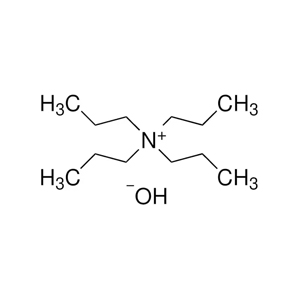Premium Tetrapropylammonium Hydroxide Solutions by Aure Chemical
Aure Chemical is a leading global supplier of high-quality Tetrapropylammonium Hydroxide (TPAH), also known as Tetra-n-propylammonium hydroxide. Identified by its CAS number 4499-86-9, TPAH is a strong organic base and a versatile quaternary ammonium compound typically supplied as an aqueous or methanolic solution. Its unique properties make it an indispensable reagent in various advanced chemical processes. TPAH is predominantly used as a structure-directing agent (SDA) in the synthesis of zeolites and other microporous materials, influencing their crystal structure and pore size. Beyond this, it serves as a powerful catalyst in numerous organic reactions, an electrolyte in electrochemical applications, and a key component in the production of specialty chemicals and high-purity materials. Aure Chemical is committed to providing TPAH that meets stringent purity and concentration requirements, ensuring consistent and reliable performance for your most demanding industrial and research applications. Partner with us for a dependable supply of this critical compound.
Basic Information of Tetrapropylammonium Hydroxide
Tetrapropylammonium Hydroxide (TPAH, CAS No. 4499-86-9) is meticulously produced and rigorously tested to meet stringent quality standards. We offer various concentrations to suit your specific application requirements:
| CAS No.: | 4499-86-9 |
|---|
| EC No.: | 224-800-6 |
|---|
| Linear Formula: | C₁₂H₂₉NO |
|---|
| Molecular Weight: | 203.37 |
|---|
| Appearance: | Clear to yellowish aqueous or methanolic solution. |
|---|
| Boiling Point: | 100-102 °C |
|---|
| Density: | 1.00 g/mL at 20 °C |
|---|
| Solubility: | Highly soluble in water and alcohols. |
|---|
| Concentration: | Available in various concentrations (e.g., 10%, 20%, 40% in water or methanol). |
|---|
| Stability: | Stable under recommended storage conditions; sensitive to carbon dioxide from air. |
|---|
| Purity: | High purity grades available for sensitive applications. |
|---|
| Chemical Structure: |  |
|---|
Our commitment to delivering high-purity TPAH ensures a reliable and efficient component for your critical processes, offering consistent quality for diverse synthetic and material science applications.
Primary Applications of Tetrapropylammonium Hydroxide (TPAH)
Tetrapropylammonium Hydroxide's properties as a strong base and a bulky cation make it invaluable in a wide range of applications:
Structure-Directing Agent (SDA) in Zeolite Synthesis:
TPAH is one of the most widely used structure-directing agents or templates in the hydrothermal synthesis of various zeolites (e.g., ZSM-5, Beta, Silicalite-1) and other porous materials. It plays a crucial role in directing the formation of specific framework structures and controlling pore dimensions.
Strong Organic Base and Catalyst:
As a strong, non-nucleophilic organic base, TPAH is employed as a catalyst or reagent in numerous organic reactions, including condensation reactions, esterifications, polymerizations, and dehydrohalogenations, especially where inorganic bases might interfere or cause side reactions.
Electrolyte in Electrochemical Applications:
TPAH is utilized as a supporting electrolyte in various electrochemical studies and processes, particularly in non-aqueous solvents, due to its high ionic conductivity and stability over a wide potential range.
Precursor for Specialty Chemicals:
It serves as a key precursor in the synthesis of other specialized quaternary ammonium compounds and derivatives, which find applications as phase-transfer catalysts, surfactants, and antimicrobial agents.
High-Purity Material Production:
In the electronics industry and other high-tech sectors, TPAH is used in the production of high-purity materials, including certain metal oxides and thin films, where precise control over pH and cation presence is required.
Etchant in Semiconductor Manufacturing:
In some semiconductor fabrication processes, TPAH solutions can be used as a selective etching agent for silicon and other materials.
Why Choose Aure Chemical for Your Tetrapropylammonium Hydroxide (TPAH) Supply?
Aure Chemical is dedicated to providing superior chemical solutions and unparalleled customer support. By partnering with us for your TPAH requirements, you benefit from:
Exceptional Purity & Consistent Quality: Our Tetrapropylammonium Hydroxide is manufactured to stringent purity and concentration specifications, crucial for achieving optimal results in sensitive zeolite synthesis, catalytic reactions, and electrochemical processes.
Reliable Global Supply Chain: We maintain a robust and efficient global supply network, guaranteeing timely and secure delivery of this essential chemical to your facilities worldwide, with flexible packaging options to meet your specific needs.
Expert Technical Support: Our dedicated team of specialists is readily available to offer comprehensive guidance on product application, handling, storage, and optimal usage in your specific chemical processes, ensuring safety and efficiency.
Commitment to Quality & Responsible Stewardship: We adhere to the highest industry standards for quality management, environmental responsibility, and product stewardship across all our operations, ensuring peace of mind for our clients and sustainable sourcing practices.
Customized Solutions: We understand that different applications may require specific concentrations or purity levels. We are open to discussing customized solutions to meet your exact requirements.
Choose Aure Chemical for a trustworthy and dependable supply of high-quality Tetrapropylammonium Hydroxide (TPAH). We're ready to support your advanced material science, organic synthesis, and electrochemical endeavors with an unwavering commitment to quality and service.

